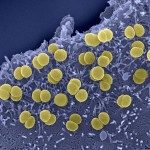Link to Pubmed [PMID] – 27553401
East. Mediterr. Health J. 2016 Aug;22(5):343-9
Neisseria meningitidis, a leading cause of bacterial meningitis and other serious infections, is responsible for approximately one-third of cases of bacterial meningitis in the Children’s Hospital of Tunis. The serogroup distribution, antibiotic susceptibility and antigenic and molecular characteristics of N. meningitidis isolates were determined in patients aged 3 days-13 years between February 1998 and June 2013. In all 107 invasive strains of N. meningitidis were isolated. Reduced susceptibility to penicillin G was seen in 55.7% of isolates, with a low level of resistance in all cases; 28.4% showed a low level of resistance to amoxicillin. Serogroup B isolates were the most frequent (80.4%), followed by serogroups C (12.2%) and A (5.6%). Isolates of serogroup A had the same antigenic formula (A:4:P1.9), the same variable regions VR1, VR2 and VR3, and belonged to the same clonal complex (CC5). Isolates of serogroups B and C were more heterogeneous with several antigenic formulae. The most frequent clonal complex in these isolates was CC35. Serogroup B accounted for a large percentage of our isolates with marked diversity.

